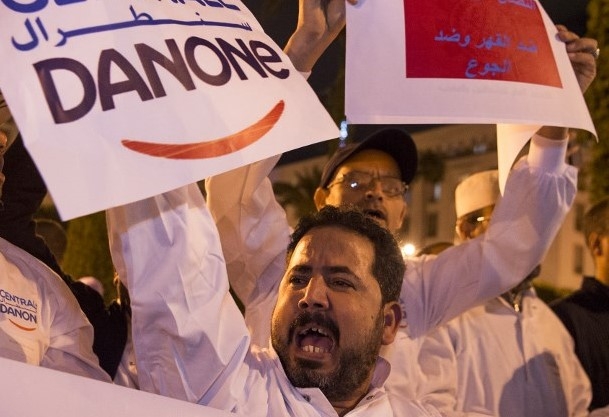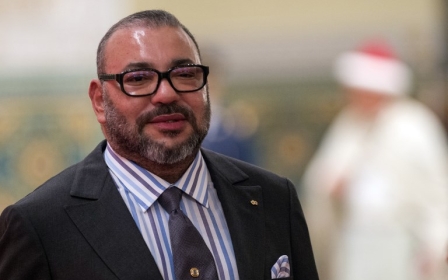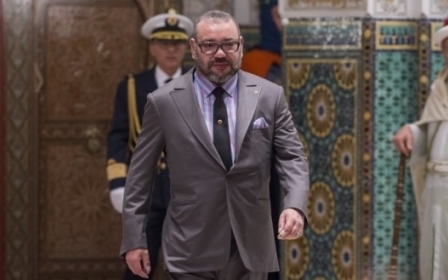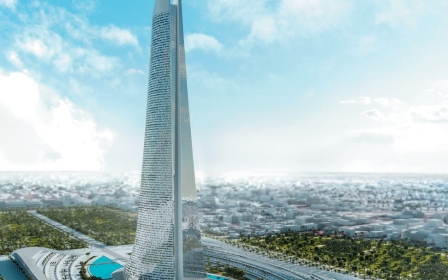Is Morocco’s boycott the future of political resistance in north Africa?
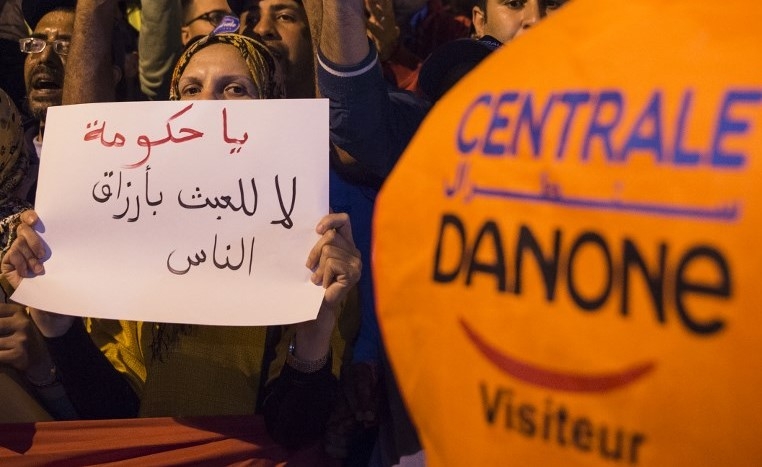
Protest movements in the Middle East and North Africa are not confined by geographical boundaries: groups pick up strategies, technologies, slogans and songs from their counterparts across the region. Traditionally, Morocco has not been a noted exporter of protest movements. But this is likely to change.
Since the repression of the Hirak movement in the Rif region, protesters in Morocco have shown remarkable creativity in organising protests that were difficult for the security services to repress, including banging pots and pans on rooftops, and marching on the beach, forcing the police to chase them into the waves of the Mediterranean.
A growing social divide
The most effective strategy, however, has been an ongoing boycott of three companies: Centrale Danone, a producer of dairy products and part of the French Danone corporation, Sidi Ali, a producer of mineral water, and Afriquia, a petrol distributor. The companies are seen as overcharging, and complicit in rising inflation and a growing social divide within the north African country.
So far, the boycott has been a success for its participants: Centrale Danone has already announced that its revenues have halved since the beginning of the boycott. The harsh public rhetoric against the boycott, calling it "treason" or "fake news", are an indication of its power, as neither titans of industry nor the state can force its end.
The boycott is surgically precise in its targets, cutting to the heart of Morocco's political economy
The boycott's success has been rooted in both its diffusion and its precision. It has been diffuse in its organisation, spreading largely through social media, and so far, no clear origin, political affiliation or leadership structure has emerged.
At the same time, the boycott is surgically precise in its targets, cutting to the heart of Morocco's political economy. Its choice of products not only highlights the rising costs of living for many Moroccans, but also the entanglement between big business and politics. Most notably, Aziz Akhannouch, the head of Afriquia, also leads the RNI party and holds a cabinet positon.
Miriem Bensalah Chekroun, the head of the company producing Sidi Ali water, is the former head of Morocco's confederation of enterprises, CGEM. It is in its focus on this intersection where this boycott movement makes a novel contribution to north Africa's protest culture.
While boycotts themselves are not entirely new in the region, ranging from the 1912 Tunis tram boycott and local chapters of BDS to the more recent Algerian car boycott, the scope and the focus of this movement are unique.
Politics and big business
Rising costs of living, an entanglement of politics and big business, and crackdowns against traditional forms of protests – none of these elements are limited to Morocco, but are instead experienced across north Africa.
This raises the question: can this form of boycott provide a model for political resistance in the region? Could it provide a space for voicing popular disapproval of austerity politics, the economic role of some of the regions’ militaries, corruption and crony capitalism?
What makes a boycott so attractive for protesters – from Montgomery to Morocco – who have experienced violent crackdowns against other forms of protests is that it is practically impossible to suppress through the security forces. While governments can rail against the boycott and crack down on websites that advertise it, the simple everyday action of not buying a certain product can hardly be prosecuted.
The organisational structure needed is minimal, immunising the movement from the risk of collapse in the case of the arrest or co-optation of its leadership. All this seems particularly applicable to the case of Egypt, which has in recent years seen the arrest and disappearance of much of the leadership of its traditional protest movements, alongside the violent crackdown on public demonstrations.
What makes a boycott so attractive for protesters is that it is practically impossible to suppress through the security forces
The boycott's diffuse structure also contains some of its symbolic power – the seemingly mundane act of not buying from a certain petrol provider provides even the poorest Moroccan with some influence on the income of the country's richest men. In the context of popular disillusionment with traditional methods of accumulating preferences – multi-party elections in particular – the boycott provides a constant referendum.
It conveys information, and its results are immediately visible in the public space, where full shelves and vacant petrol stations can be observed, and changing prices can be verified. This easily extends the tactic’s relevance to Tunisia, which has seen a larger space for more standard forms of political participation and protest, but is experiencing an increasing disillusionment with their ability to affect political change.
New challenges
While boycotts solve some of the problems of protest movements across north Africa, however, they also create new challenges. As is becoming increasingly visible in Morocco, diffuse structures also limit their ability to formulate clear demands, negotiate on the basis of these demands, respond to criticism of the movement and, eventually, end the boycott.
Boycotts against domestic producers are likely to face criticism that they are hurting the economy and endangering the jobs of their compatriots working in the boycotted companies. This is a difficult line to walk and communicate for any political movement, and becomes a particular challenge for one without a clear leadership structure.
There are also class effects to consider – not everyone consumes the same type of products, and not everyone shares the same ability to substitute them, or go without using them. Many of the products that may be targets for protest movements, such as those produced by firms connected to the army in Egypt, or crony capitalists in Tunisia, are basic goods that are costly to avoid in a context of already high levels of inflation.
In light of these challenges, the likely success of future boycotts in north Africa will depend on movements' ability to navigate these challenges, as well as the products and industries they target. Until then, the further developments in Morocco will be watched with much care throughout the region. It might become an unlikely exporter of protest movements after all.
- Max Gallien is a PhD candidate in international development at the London School of Economics, specialising in the political economy of north Africa. He holds an MPhil in modern Middle Eastern studies from the University of Oxford, and was a scholar in residence at Al-Akhawayn University in Morocco. Twitter: @MaxGallien.
The views expressed in this article belong to the author and do not necessarily reflect the editorial policy of Middle East Eye.
Photo: A demonstrator holds a sign as employees of the company Centrale Danone, a subsidiary of French multinational Danone, protest in front the parliament in Rabat on 5 June 2018, against the boycott of the brand in Morocco (AFP).
This article is available in French on Middle East Eye French edition.
Middle East Eye propose une couverture et une analyse indépendantes et incomparables du Moyen-Orient, de l’Afrique du Nord et d’autres régions du monde. Pour en savoir plus sur la reprise de ce contenu et les frais qui s’appliquent, veuillez remplir ce formulaire [en anglais]. Pour en savoir plus sur MEE, cliquez ici [en anglais].



